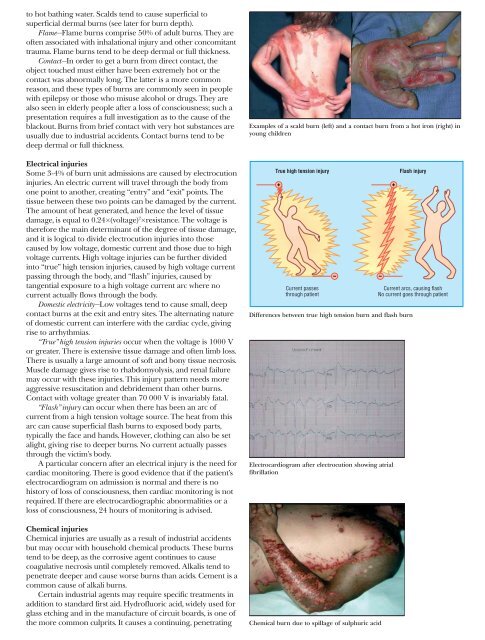ABC of Burns
Create successful ePaper yourself
Turn your PDF publications into a flip-book with our unique Google optimized e-Paper software.
to hot bathing water. Scalds tend to cause superficial to<br />
superficial dermal burns (see later for burn depth).<br />
Flame—Flame burns comprise 50% <strong>of</strong> adult burns. They are<br />
<strong>of</strong>ten associated with inhalational injury and other concomitant<br />
trauma. Flame burns tend to be deep dermal or full thickness.<br />
Contact—In order to get a burn from direct contact, the<br />
object touched must either have been extremely hot or the<br />
contact was abnormally long. The latter is a more common<br />
reason, and these types <strong>of</strong> burns are commonly seen in people<br />
with epilepsy or those who misuse alcohol or drugs. They are<br />
also seen in elderly people after a loss <strong>of</strong> consciousness; such a<br />
presentation requires a full investigation as to the cause <strong>of</strong> the<br />
blackout. <strong>Burns</strong> from brief contact with very hot substances are<br />
usually due to industrial accidents. Contact burns tend to be<br />
deep dermal or full thickness.<br />
Electrical injuries<br />
Some 3-4% <strong>of</strong> burn unit admissions are caused by electrocution<br />
injuries. An electric current will travel through the body from<br />
one point to another, creating “entry” and “exit” points. The<br />
tissue between these two points can be damaged by the current.<br />
The amount <strong>of</strong> heat generated, and hence the level <strong>of</strong> tissue<br />
damage, is equal to 0.24×(voltage) 2 ×resistance. The voltage is<br />
therefore the main determinant <strong>of</strong> the degree <strong>of</strong> tissue damage,<br />
and it is logical to divide electrocution injuries into those<br />
caused by low voltage, domestic current and those due to high<br />
voltage currents. High voltage injuries can be further divided<br />
into “true” high tension injuries, caused by high voltage current<br />
passing through the body, and “flash” injuries, caused by<br />
tangential exposure to a high voltage current arc where no<br />
current actually flows through the body.<br />
Domestic electricity—Low voltages tend to cause small, deep<br />
contact burns at the exit and entry sites. The alternating nature<br />
<strong>of</strong> domestic current can interfere with the cardiac cycle, giving<br />
rise to arrhythmias.<br />
“True” high tension injuries occur when the voltage is 1000 V<br />
or greater. There is extensive tissue damage and <strong>of</strong>ten limb loss.<br />
There is usually a large amount <strong>of</strong> s<strong>of</strong>t and bony tissue necrosis.<br />
Muscle damage gives rise to rhabdomyolysis, and renal failure<br />
may occur with these injuries. This injury pattern needs more<br />
aggressive resuscitation and debridement than other burns.<br />
Contact with voltage greater than 70 000 V is invariably fatal.<br />
“Flash” injury can occur when there has been an arc <strong>of</strong><br />
current from a high tension voltage source. The heat from this<br />
arc can cause superficial flash burns to exposed body parts,<br />
typically the face and hands. However, clothing can also be set<br />
alight, giving rise to deeper burns. No current actually passes<br />
through the victim’s body.<br />
A particular concern after an electrical injury is the need for<br />
cardiac monitoring. There is good evidence that if the patient’s<br />
electrocardiogram on admission is normal and there is no<br />
history <strong>of</strong> loss <strong>of</strong> consciousness, then cardiac monitoring is not<br />
required. If there are electrocardiographic abnormalities or a<br />
loss <strong>of</strong> consciousness, 24 hours <strong>of</strong> monitoring is advised.<br />
Chemical injuries<br />
Chemical injuries are usually as a result <strong>of</strong> industrial accidents<br />
but may occur with household chemical products. These burns<br />
tend to be deep, as the corrosive agent continues to cause<br />
coagulative necrosis until completely removed. Alkalis tend to<br />
penetrate deeper and cause worse burns than acids. Cement is a<br />
common cause <strong>of</strong> alkali burns.<br />
Certain industrial agents may require specific treatments in<br />
addition to standard first aid. Hydr<strong>of</strong>luoric acid, widely used for<br />
glass etching and in the manufacture <strong>of</strong> circuit boards, is one <strong>of</strong><br />
the more common culprits. It causes a continuing, penetrating<br />
Examples <strong>of</strong> a scald burn (left) and a contact burn from a hot iron (right) in<br />
young children<br />
True high tension injury<br />
Current passes<br />
through patient<br />
Differences between true high tension burn and flash burn<br />
Electrocardiogram after electrocution showing atrial<br />
fibrillation<br />
Chemical burn due to spillage <strong>of</strong> sulphuric acid<br />
Flash injury<br />
Current arcs, causing flash<br />
No current goes through patient



